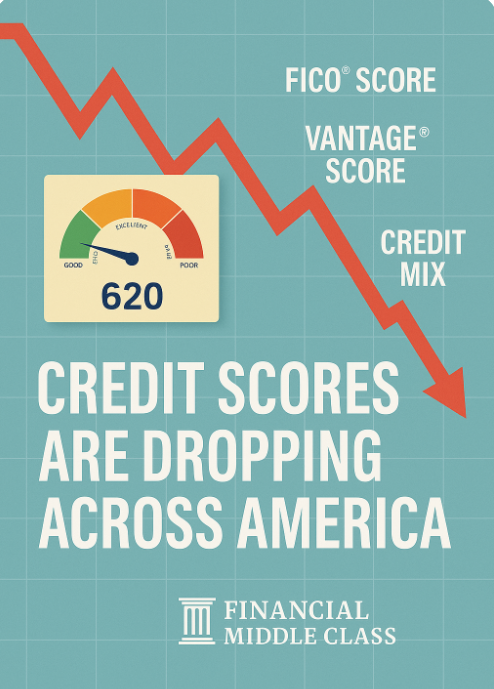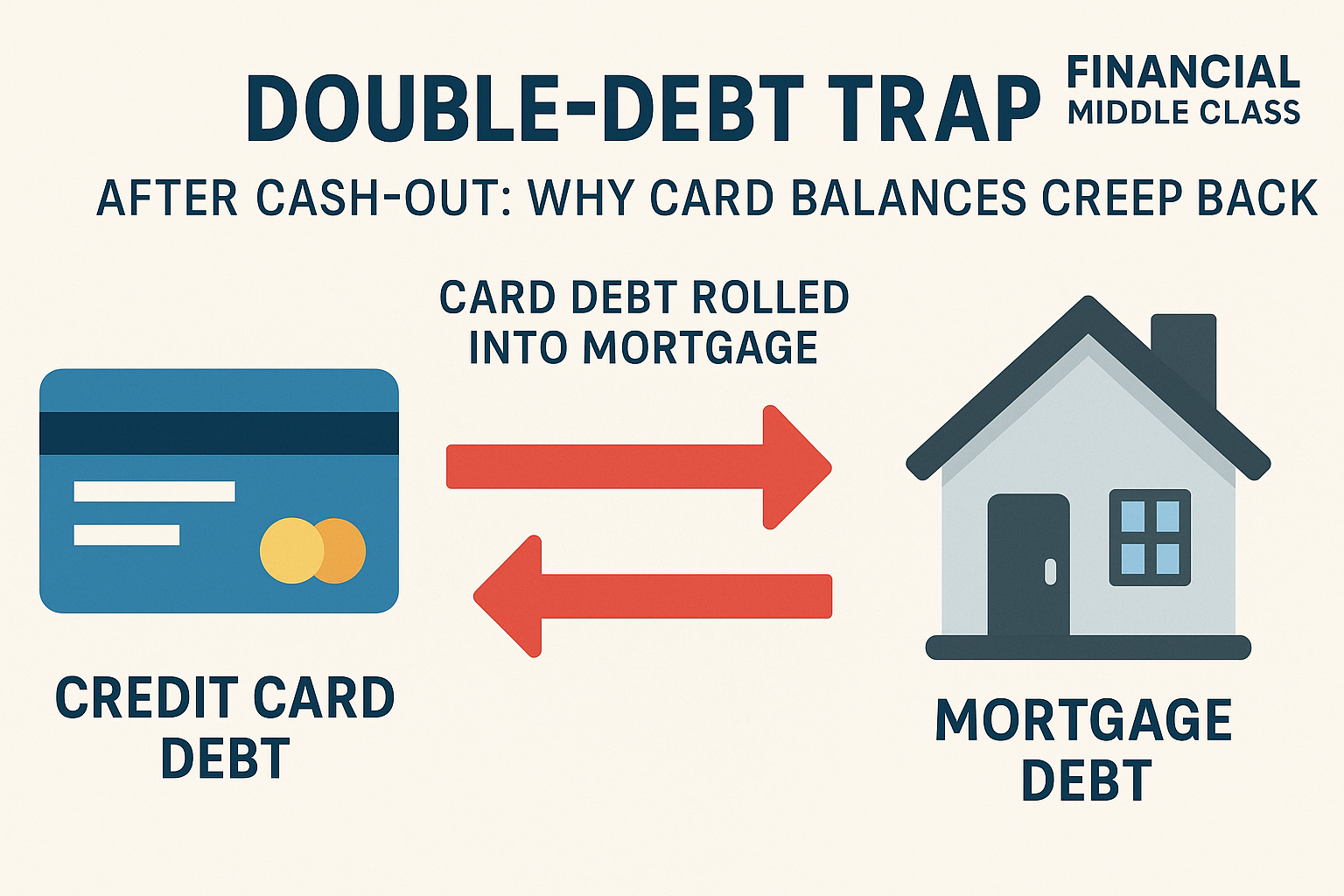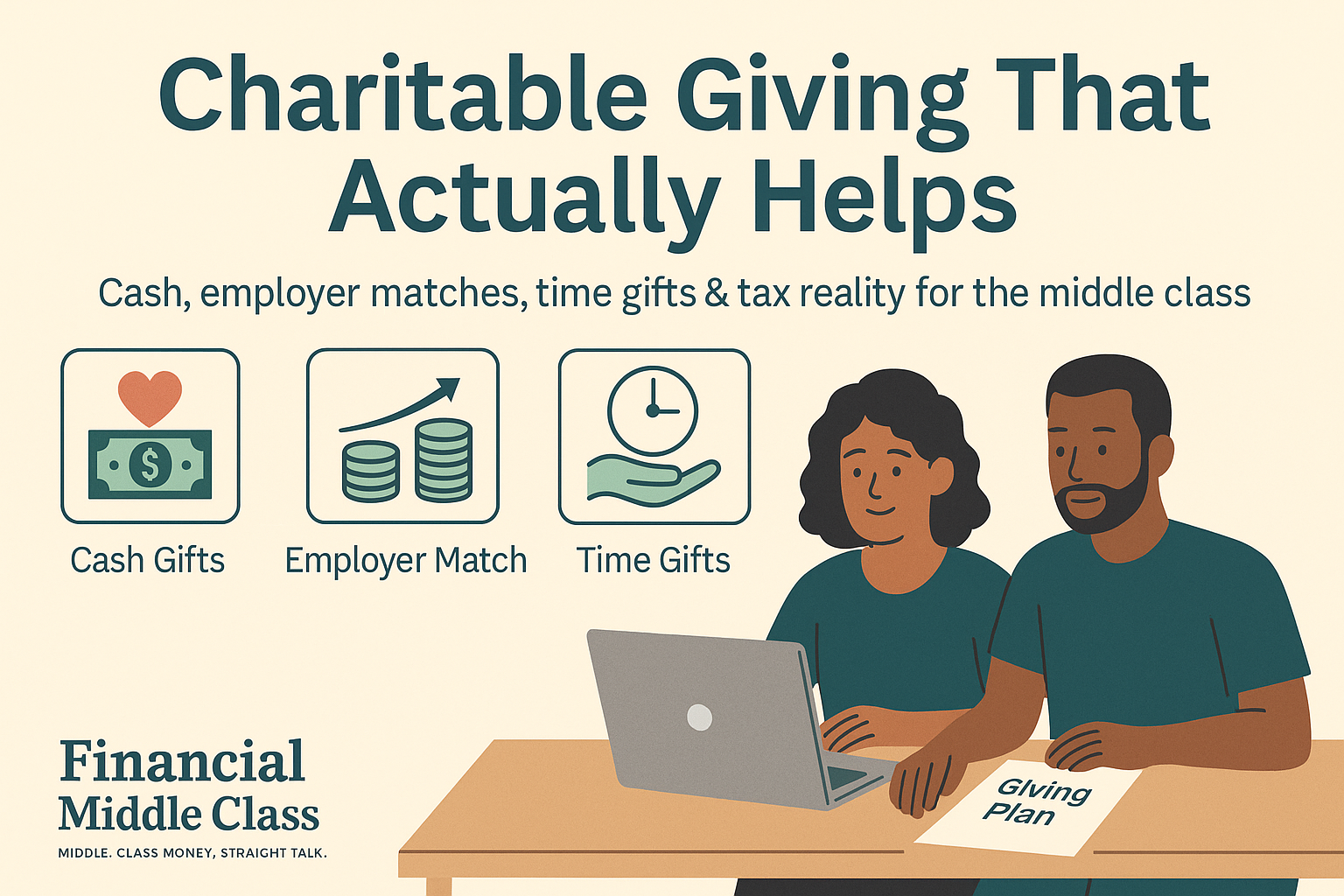
Credit Scores Are Dropping Across America: Here’s Why It’s Happening
By Article Posted by Staff Contributor
The estimated reading time for this post is 308 seconds
Credit scores in the U.S. are slipping, and fast. The average FICO® Score has dropped to 715 in 2025, down from its pandemic-era highs. For some borrowers, especially younger Americans and those carrying heavy balances, the decline has been much steeper.
So why is this happening? It’s not just one thing. Rising credit card balances, sky-high interest rates, the return of student loan reporting, and mounting delinquencies are all dragging scores down. Let’s unpack what’s going on — and what you can do if your score is slipping too.
Where Credit Scores Stand Today
- Average FICO® Score (2025): 715 (down 2 points year over year)
- Average VantageScore® (2025): ~701
- Credit card utilization: now at 35% nationally, up from the low 20s during the pandemic
- Delinquencies: 4.4% of all household debt is delinquent, with student loans and auto loans leading the surge
Younger borrowers — especially Gen Z — have seen the steepest declines. Their files are thinner, they carry smaller but more expensive balances, and they’re more likely to be hit by resumed student loan payments.
Why Scores Are Falling
Credit scores are built on five main factors. Right now, three of them are flashing red:
1. Payment History (35% of score)
Missed payments are rising. Student loan delinquencies spiked to 10% of balances 90+ days past due in 2025 after pandemic-era protections ended. Bankcard delinquencies are also up nearly 50% since 2021. A single 30-day late can tank a score by 90+ points.
2. Amounts Owed / Utilization (30% of score)
Credit card balances are up, and so are rates. The average card APR is now above 22%, with store cards often pushing 30% or higher. That keeps utilization stuck in the “red zone” above 30%.
3. New Credit & Account Mix
Lenders are still issuing new cards, including to subprime borrowers. This shifts averages down since those borrowers are more likely to miss payments or max out lines.
The Bigger Forces Behind the Drop
- Student Loans Return to Reports: For three years, missed federal loan payments weren’t reported. That shield is gone. Now millions of borrowers who fell behind are seeing their credit files damaged.
- Record Credit Card APRs: It’s not just balances — it’s the cost. With APRs near all-time highs, more of each payment goes to interest instead of principal. That makes it harder to pay debt down.
- Auto Loan Stress: Auto delinquencies are the highest in more than a decade, adding derogatory marks to credit reports and straining household budgets.
- Tighter Credit Lines: Banks cut credit limits for some riskier customers. Even if your balance doesn’t change, a lower limit raises your utilization percentage, which drags your score.
- Sticky Inflation: Gas, insurance, and rent may have cooled a bit, but they’re still high enough to keep households leaning on credit cards month after month.
Why Scores Didn’t Hold Up Better
There were some tailwinds. For example, the big credit bureaus removed most medical collections from reports in 2022–23. And in January 2025, the CFPB moved to remove all medical debt from credit files. But a federal court struck down that rule in July, blunting the impact.
In other words, the positives weren’t nearly strong enough to counteract the surge in missed payments and ballooning balances.
Who’s Hurt the Most
- Gen Z borrowers: Thin files, higher utilization, and student loans weigh heavily.
- Lower-income households: More likely to revolve balances and face late payments.
- Subprime consumers: Delinquencies hit these groups first and hardest.
What You Can Do About It
You don’t control interest rates or lender policies. But you do control how your credit usage shows up on your report. Here’s a step-by-step playbook to protect (and even rebuild) your score in today’s environment:
1. Keep utilization low — aim for 30%, thrive at 10%
- Example: If you have a $5,000 limit, keeping your balance under $1,500 (30%) avoids red flags. Staying under $500 (10%) puts you in excellent territory.
- Tactics: Pay twice per month (before your statement date), request a credit limit increase, and spread charges across cards instead of maxing out one.
2. Never miss a due date — automate it
- Example: A single missed $90 payment can slice 90–120 points off your score.
- Tactics: Set auto-pay for the minimum, sync due dates across cards, and set calendar reminders for extra payments.
3. Attack high-APR balances first
- Example: A $3,000 balance at 25% APR racks up $62 in interest per month. A 0% balance transfer card could save you $700+ in a year.
- Tactics: Use the avalanche method (target the highest APR debt), explore balance transfers, or refinance with a lower-rate personal loan.
4. Protect yourself from student loan delinquencies
- Example: Missing two $150 student loan payments can drop your score fast.
- Tactics: Enroll in an IDR plan — even $0 counts as “on-time.” Set up auto-debit with your servicer for extra safety.
5. Pull your credit reports and audit them
- Example: Errors are common — 1 in 5 Americans has one.
- Tactics: Check reports weekly at AnnualCreditReport.com, dispute incorrect late payments or collections, and monitor for duplicate accounts.
Real-World Case Studies
Maria (Middle-Class Borrower)
- Problem: Score dropped to 620 from high balances and one missed payment.
- Action: She asked for a credit line increase, paid twice a month, set auto-pay, and refinanced high-APR debt.
- Result: Score rose to 690 in six months.
Jamal (Gen Z Borrower with Student Loans)
- Problem: Score fell to 605 after missing student loan payments.
- Action: Enrolled in the SAVE Plan ($0 payment counted as on-time), opened a secured card, kept utilization low.
- Result: Score climbed to 668 within nine months.
Linda (Retiree Managing Debt)
- Problem: 590 score with $8,500 in card debt and a medical collection.
- Action: Used the snowball method, settled the collection, and shifted balances to a 0% intro APR card.
- Result: Score improved to 662 within a year, and her debt burden shrank significantly.
Final Word
America’s average credit score is falling because debt has gotten more expensive, more people are falling behind, and lenders aren’t cutting much slack. But you’re not powerless. By controlling utilization, avoiding late payments, and restructuring expensive debt, you can keep your score from spiraling — even in a tougher credit environment.
These case studies show it’s possible. Whether you’re a young borrower battling student loans, a working professional juggling cards, or a retiree handling medical bills, the principles are the same: pay on time, keep balances low, and check your reports often.
RELATED ARTICLES
PMI Exit Plan: How to Remove PMI Faster and Reclaim Cash Flow
The estimated reading time for this post is 320 seconds PMI Exit Plan: How to Remove PMI and Reclaim Cash Flow Financial Middle Class | PMI Exit Plan – How to remove mortgage insurance faster and reclaim monthly cash flow....
The Double-Debt Trap After Cash-Out: Why Card Balances Creep Back
The estimated reading time for this post is 1163 seconds Home » Debt » Double-Debt Trap After Cash-Out The Double-Debt Trap After Cash-Out: Why Card Balances Creep Back Rolling card debt into your mortgage sounds smart, but it can trigger...
Leave Comment
Cancel reply

PMI Exit Plan: How to Remove PMI Faster and Reclaim Cash Flow

The Double-Debt Trap After Cash-Out: Why Card Balances Creep Back

Charitable Giving That Actually Helps (and Helps Your Taxes)
Gig Economy
American Middle Class / Nov 22, 2025
PMI Exit Plan: How to Remove PMI Faster and Reclaim Cash Flow
The estimated reading time for this post is 320 seconds PMI Exit Plan: How to Remove PMI and Reclaim Cash Flow Financial Middle Class | PMI...
By Article Posted by Staff Contributor
American Middle Class / Nov 21, 2025
The Double-Debt Trap After Cash-Out: Why Card Balances Creep Back
The estimated reading time for this post is 1163 seconds Home » Debt » Double-Debt Trap After Cash-Out The Double-Debt Trap After Cash-Out: Why Card Balances...
By Article Posted by Staff Contributor
American Middle Class / Nov 20, 2025
Charitable Giving That Actually Helps (and Helps Your Taxes)
The estimated reading time for this post is 697 seconds Charitable Giving That Actually Helps (and Helps Your Taxes) You’ve probably had this moment: you’re juggling...
By Article Posted by Staff Contributor
American Middle Class / Nov 20, 2025
Kid Magic on a Budget: Memory-First Traditions: Low-cost rituals that outlast the plastic toys forgotten by February
The estimated reading time for this post is 906 seconds Home › Family & Money › Kid Magic on a Budget Kid Magic on a Budget:...
By Article Posted by Staff Contributor
American Middle Class / Nov 20, 2025
Scams, “Limited Time” Pressure, and Fake Charity Drives
The estimated reading time for this post is 1364 seconds Scam Red Flags, “Limited Time” Pressure, and Fake Charity Drives A red-flag checklist and two-step verification...
By Article Posted by Staff Contributor
American Middle Class / Nov 19, 2025
Balancing Emotions and Money When the Holidays Hit Hard
The estimated reading time for this post is 1322 seconds Every year, somewhere between the first Christmas commercial and the last day of school before winter...
By MacKenzy Pierre
American Middle Class / Nov 19, 2025
New IRS Retirement Limits for 2026: Will You Actually Use Them?
The estimated reading time for this post is 756 seconds Americans can put more into 401(k)s, IRAs, and SIMPLE plans in 2026—and higher earners will see...
By Article Posted by Staff Contributor
American Middle Class / Nov 19, 2025
Behind on Your Mortgage? A Step-by-Step Guide to the Foreclosure Process
The estimated reading time for this post is 1060 seconds In October, lenders started the foreclosure process on more than 25,000 homes across the country —...
By Article Posted by Staff Contributor
American Middle Class / Nov 16, 2025
It’s Not About How Much You Make — It’s How Much You Keep
The estimated reading time for this post is 504 seconds Many Americans are earning more than ever, but far too many have almost nothing to show...
By Article Posted by Staff Contributor
American Middle Class / Nov 15, 2025
Portable Mortgages: Why the Middle Class Should Be Able to Take Their 3% Rate With Them
The estimated reading time for this post is 1209 seconds If you’re sitting on a 3% mortgage right now, congratulations — and I’m sorry. Congratulations, because...
By Article Posted by Staff Contributor
Latest Reviews
American Middle Class / Nov 22, 2025
PMI Exit Plan: How to Remove PMI Faster and Reclaim Cash Flow
The estimated reading time for this post is 320 seconds PMI Exit Plan: How to...
American Middle Class / Nov 21, 2025
The Double-Debt Trap After Cash-Out: Why Card Balances Creep Back
The estimated reading time for this post is 1163 seconds Home » Debt » Double-Debt...
American Middle Class / Nov 20, 2025
Charitable Giving That Actually Helps (and Helps Your Taxes)
The estimated reading time for this post is 697 seconds Charitable Giving That Actually Helps...



